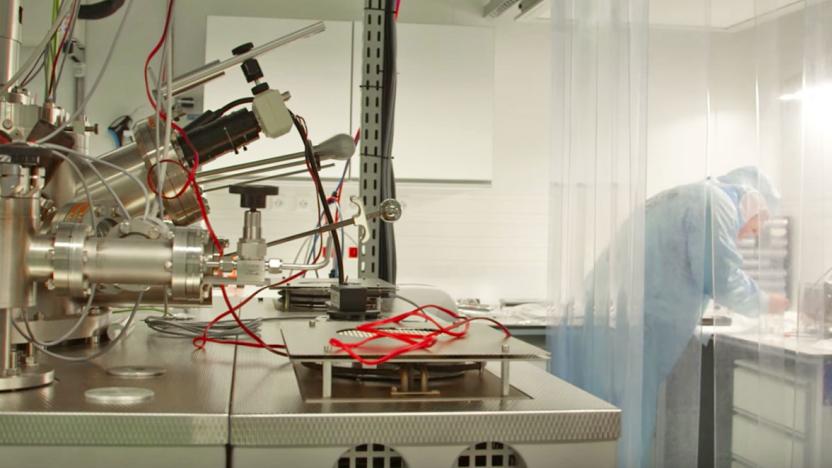nanomaterials
Latest

NASA backs tiny 3D-printed sensors for planetary rovers
Nanomaterials might just prove the key to the next wave of planetary rovers. NASA has poured $2 million into a Goddard Space Flight Center team developing 3D-printed sensors whose nanomaterials make them tiny, ultra-sensitive and resistant to radiation. The aim is to build a device that can detect minuscule (on the parts-per-billion-level) amounts of life-supporting chemicals like ammonia, hydrogen, methane and water.

Nanomaterial charges everyday batteries in seconds
If you want a battery that charges in seconds rather than hours, you go for a supercapacitor. There are some catches to that, though: either you give up the long-lasting energy of a chemical battery (like the lithium pack in your phone) or have to resort to exotic storage tech to get a long lifespan. Drexel researchers think they have a better balance. They've developed electrodes based on a nanomaterial, MXene, that promise extremely quick charging times for chemical batteries. The near-2D design combines an oxide-metal 'sandwich' with hydrogel to create a structure that's extremely conductive, but still lets ions move freely as the battery builds up a charge. In the lab's design, you can charge MXene electrodes within "tens of milliseconds" -- you could top up a phone in seconds or an electric car in minutes.

Prepare for the world's first nanocar race this month
Nanotechnology is fascinating, but for most people who aren't full-time chemists, it's a ridiculously dense field of study. An international team of scientists are trying to make nanotechnology more accessible to the public with the world's first nanocar race, scheduled to start on April 28th in the French city of Toulouse. Six teams hailing from three continents will gather at the Centre for Materials Elaboration and Structural Studies and attempt to jolt their custom nanocars across a polished gold track 100 nanometers in length (roughly one-thousandth the width of a human hair).

Nanotechnology discovery could lead to low-power night vision
Night vision technology is essential on the modern battlefield but is not without its shortcomings. Conventional night vision goggles (NVGs) have been compared to looking "through toilet paper tubes" on account of their drastically diminished peripheral view. Even the top-of-the-line L-3 Ground Panoramic NGVs -- the ones used by US special forces during the Osama bin Laden raid -- are heavy, cumbersome and require an external power source. However, a breakthrough discovery out of the Australian National University could give us NGVs that are no thicker than a pair of normal sunglasses.

Your next heart monitor could be graphene-coated Silly Putty
For a child's toy, Silly Putty has some downright crazy physical properties. The mixture of boric acid and silicon oil, originally developed as a synthetic replacement for rubber, is a non-Newtonian fluid. Its viscosity isn't affected by temperature, but rather external force -- that is, its rate of flow depends on how hard you push or stretch it. And while its original inventors were content to leave it as a plaything, a team of researchers from Trinity College in Dublin, Ireland are about to put it to work in the medical field.

Scientists made the blackest material ever
Scientists may have made a breakthrough in materials that can help manipulate light at nanoscale, but is it really, really, really black? No. Researchers at Saudi Arabia's King Abdulla University of Science and Technology have created a carbon-nanotube material that absorbs 98 to 99 percent of light (at all angles) between 400 and 1,400nm. But there's actually a reason why something that black needs to exist. These absorbers take on important roles when it comes to solar power absorption and optical interconnects, where fiberoptic data is being passed around. Researchers were able to put a small concentration of their special nanoparticles into a solution, which gave 26 percent more absorption than carbon nanotube -- the previous prince of (material) darkness. For now, there's none more black.

Scientists build silicon transistor just one atom thick
Step aside, graphene, "silicene" is the trendy new nano-material in town that could one day supercharge future tech. Scientists have created the world's first transistor out of the silicon-based material, and it's a mere one atom thick. Unlike its much-maligned graphene cousin -- which has yet lived up to its vast potential -- silicene is a much more interesting material for computer scientists. Thanks to the silicon base, it can form "band gaps" necessary for transistors, which could one day lead to faster chips that consume less power.

Nature-inspired nano-material builds a better electrode, points to greener future (video)
From the apple falling on Newton's head to batteries made out of root extract, scientists have long turned to nature for ideas. Following that tradition, the brainiacs over at the University of Reading have developed a new nano-material electrode coating based on the cellular structure of plants. Essentially a network of tiny wires, it features a larger surface area than flat electrodes, giving it the leverage it needs to convert more electricity in a smaller form factor. This could lead to cheaper cell production and good things for the future of green energy. "This novel electrode coating technique has applications for fuel cells in the newest generation of hybrid cars, photovoltaic cells, rechargeable batteries or battery production for a wide range of green technologies," said the university's Dr. Adam Squires. Hopefully this sort of technology makes its way to consumers in a timely fashion, but in the meantime we can't help but marvel at how this nature-inspired technology is being used to save its muse. Poetic, isn't it? To find out how the nano-material is made, check out the source and the video after the break.

Scientist cooks up adjustable strength metals
As you may know, crafting a katana is a delicate process that involves carefully constructing a razor-sharp high-carbon edge around a soft shock-absorbent core. One day though, smiths and forging fires could be replaced by electrode-wielding mad-scientists, with the technology to selectively harden and soften metal at will. At least that's what we envisioned when we read about Jörg Weißmüller's breakthrough research in the field of nanomaterials. The German scientist discovered that by placing precious metals in acid he could create tiny ducts through corrosion. Once those channels are flooded with a conductive liquid, electrical currents can be used to harden the material and, if you change your mind about the brittle results, the effect can easily be reversed to make it soft again. The tech could eventually lead to self-healing vehicle armor or scratch-resistant cellphones -- but, really, we just want to zap our way to a high-quality samurai sword.

LG and QD Vision unite for QLEDs: the quantum dot displays of our power-efficient future
Seems like LG really has a thing for those quantum dot LEDs. After hooking up with Nanosys earlier this year, the Korean giant is now stretching out another of its tentacles -- LG Display, to be specific -- for a partnership with a competing QLED designer in QD Vision. What's being promised by this joint venture falls right in line with your generic pipe dream -- better color accuracy than OLEDs, up to twice the power efficiency at a given color purity, and a cheap and straightforward manufacturing process. In fact, because QLEDs do not require the same glass substrate as most current display technologies, they offer unmatched flexibility (olé!) in terms of how and where they may be used. The only downer, and you had to know there would be one, is that QD Vision describes its tech as still in the "development stage," but hey, at least we have another cool acronym to add to our library.






